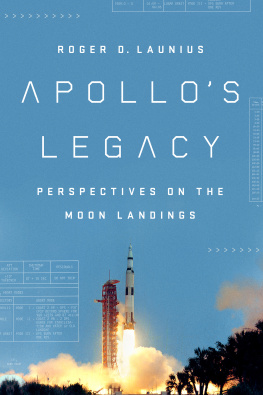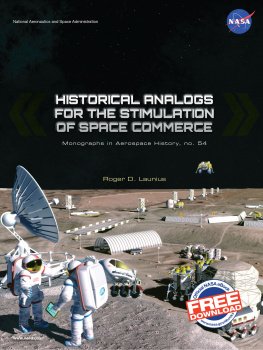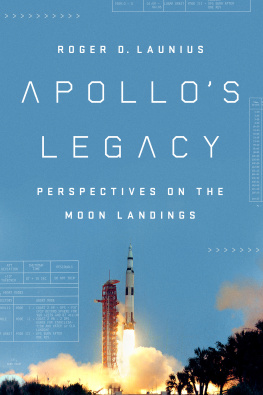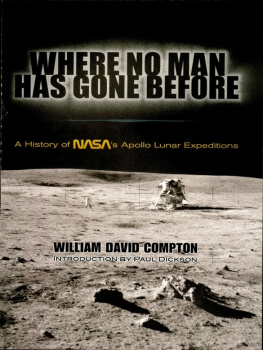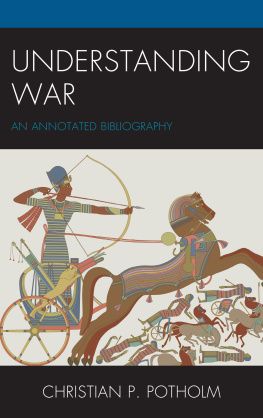Preface
Table of Contents
When future generations review the history of the twentieth century they will judge humanity's movement into space, with both machines and people, as one of its most important developments. Even at this juncture the compelling nature of space flight, and the activity that it has engendered on the part of many peoples and governments, makes the U.S. civil space program a significant area of investigation. People from all avenues of experience and levels of education share an interest in, if not always an attraction to, the drama of space flight. No doubt the lunar landing of Apollo 11 in the summer of 1969 is the high point of this continuing drama.
Although President John F. Kennedy had made a public commitment in 1961 to land an American on the Moon by the end of the decade, before this time Apollo had been all promise, and now the realization was about to begin. Its success was an enormously significant accomplishment coming at a time when American society was in crisis; if only for a few moments the world united as one to focus on the historic occasion.
Apollo 11 lifted off on July 16, 1969, and after confirmation that the hardware was working well began the three day trip to the Moon. Then, at 4:18 p.m. EST on 20 July 1969 the Lunar Module-- with astronauts Neil A. Armstrong and Edwin E. Aldrin--landed on the lunar surface while Michael Collins orbited overhead in the Apollo command module. After checkout, Armstrong set foot on the surface, telling millions who saw and heard him on Earth that it was "one small step for man--one giant leap for mankind." Aldrin soon followed him out and the two plodded around the landing site in the 1/6 lunar gravity, planted an American flag but omitted claiming the land for the U.S. as had been routinely done during European exploration of the Americas, collected soil and rock samples, and set up scientific experiments. The next day they launched back to the Apollo capsule orbiting overhead and began the return trip to Earth, "splashing down" in the Pacific on July 24.
This flight rekindled the excitement felt in the early 1960s during the first Mercury space flights, and set the stage for later Apollo landing missions. An ecstatic reaction circled the globe, as everyone shared in the success of the mission. Ticker tape parades, speaking engagements, public relations events, and a world tour by the astronauts served to create good will both in the U.S. and abroad. Five more landing missions followed through December 1972, three of them using a lunar rover vehicle to travel in the vicinity of the landing site, but none of them equalled the excitement of Apollo 11.
During and since the completion of the Apollo 11 landing twenty-five years ago numerous books, studies, reports, and articles have been written about the project. This selective, annotated bibliography discusses primarily those works judged to be most essential for researchers seeking to learn more about the Apollo program's varied history. It should be noted that the word "selective" is judiciously chosen here; the works listed below do not begin to exhaust the list of those that could have been included. A complete bibliography of books and articles on lunar science alone would at least double the size of the present bibliography. It should also be noted that many of the works included below are not recommended to researchers but are included here to give them a sense of some relevant titles that they may not wish to consult. A thematic arrangement of material concerning the project will, it is hoped, bring clarity and simplicity to such a complex subject. Any such division is necessarily somewhat arbitrary, but subjects include Apollo and its precursors, the race with the Soviets, the Apollo decision, Apollo technology, operations (including coverage of specific missions and reference works dealing with lunar photography, for want of a better place to put the latter), popular culture and promotion of spaceflight, science, the astronauts, and the management of the Apollo program, with a section on juvenile literature at the end. Along with a summary of the contents of each item, judgments have been made on the quality, originality, or importance of some of these publications. An index concludes this work.
Many people assisted in producing this compilation. Lee D. Saegesser, ably assisted by William S. Skerrett and Jennifer M. Hopkins, was instrumental in obtaining many of the documents listed below, and the three of them selected the photos that appear in the bibliography and on its cover; J.D. Hunley compiled roughly half of the entries, then edited and critiqued the text; Patricia Shephard typed portions of the manuscript; the staffs of the NASA Headquarters Library and the Scientific and Technical Information Program provided expert assistance in locating bibliographical materials; Martin Manning of the United States Information Agency provided a copy of a USIA report; and the NASA Headquarters Printing and Design Center developed the layout and handled printing. Special thanks go to Dr. Joseph N. Tatarewicz who provided a great deal of information for the entries in Chapter 7 on Science.
This is the second publication in a new series of special studies prepared by the NASA History Office. The Monographs in Aerospace History series is designed to provide a wide variety of studies relative to the history of aeronautics and space. This series' publications are intended to be tightly focused in terms of subject, relatively short in length, and reproduced in an inexpensive format to allow timely and broad dessimination to researchers in aerospace history. Suggestions for additional publications in the series are welcome.
ROGER D. LAUNIUS
Chief Historian
National Aeronautics and Space Administration
General Works
Table of Contents
Alexander, T. "The Unexpected Payoff of Project Apollo." Fortune. 80 (July 1969): 114-117, 150, 153-154, 156. Written before the first lunar landing, this article argues that Project Apollo had already restored the damaged self-esteem of the United States, its original purpose. It had also developed techniques for managing thousands of individuals from government, universities, and the private sector to achieve a fixed goal, and it appeared to have achieved that goal for very nearly the cost projected at the outset of the project. The article goes on to discuss NASA's project management system that yielded so successful an outcome.
Anderton, David A. Man in Space [also entitled America in Space/The First Decade]. Washington, DC: NASA EP-48, 1968. This pamphlet contains information on Mercury, Gemini, and Apollo, launch vehicles, test vehicles, astronauts, pressure suits, and space medicine, but it treats each subject in overview fashion.
Andrews, John Williams. A.D. Twenty-One Hundred: A Narrative of Space. Boston: Branden Press, 1969. This is an epic poem of Project Apollo. It contains a foreword by Walter Cronkite who concluded that Williams had turned the space "experience into meaningful felt reality, as Housman made us feel springtime in Shropshire, or Frost, wintertime in Vermont." Apollo in its Historical Context. Washington, DC: The George Washington University Space Policy Institute, 1990. See under Logsdon, John M.




